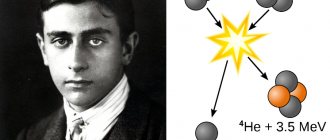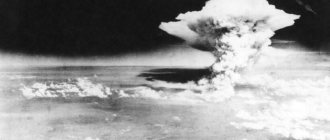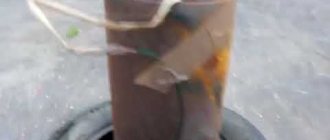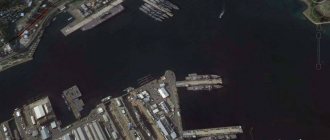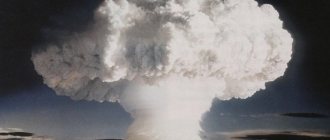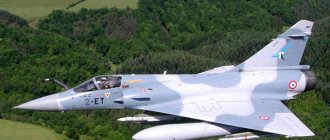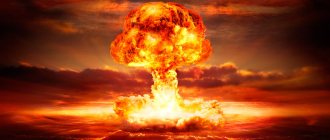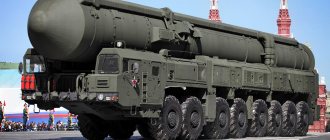All nuclear explosions on one map
The American company Esri has developed an interactive map
, which shows all 2,624 successful nuclear explosions since 1945, reports independent.
The first successful nuclear explosion in history was the Trinity test conducted by the US Army in July 1945. The explosion energy of that bomb was equivalent to approximately 21 kilotons of TNT. One of the project leaders, Robert Oppenheimer, an American theoretical physicist, said: “We knew that the world would not be the same. Some laughed, some cried, but most people were silent, and I remembered a line from the Hindu scripture: “I have become Death, the destroyer of Worlds.” In August 1945, the United States dropped nuclear bombs on the Japanese cities of Hiroshima and Nagasaki. A total of a quarter of a million people died, all but 20,000 of whom were civilians. However, it is now known that the bombs dropped on the Japanese were not very powerful. In addition, they exploded before reaching the ground. The explosions in Hiroshima and Nagasaki are the only use of nuclear weapons in wartime, but at the same time they gave impetus to successful nuclear tests proliferating throughout the globe.
The first Soviet atomic bomb, tested on August 29, 1949 at the Semipalatinsk test site, was copied from an American model.
Great Britain followed the example of the USSR and on October 3, 1952, in the area of the Monte Bello Islands (northwest of Australia), carried out the first test of surface nuclear weapons. The result was an explosion with a yield of about 25 kilotons. In 1960, France chose the Algerian desert to detonate a device three times more powerful than the bomb dropped on Nagasaki.
The most powerful nuclear weapon tested is the Tsar Bomba, developed in the USSR. The total energy of the explosion, according to various sources, ranged from 57 to 58.6 megatons of TNT. The bomb was tested on October 30, 1961. Result: the fireball of the explosion reached a radius of approximately 4.6 kilometers, the nuclear mushroom rose to a height of 67 kilometers, the diameter of its two-tier “cap” reached (at the top tier) 95 kilometers. The bomb was 1,500 times more powerful than those dropped on Hiroshima and Nagasaki.
The largest nuclear weapon, Castle Bravo, was tested on March 1, 1954 at Bikini Atoll (Republic of the Marshall Islands, associated with the United States). In addition, this weapon is the most powerful of all US nuclear tests. The explosion was three times stronger than scientists predicted. The cloud formed after the Castle Bravo explosion drifted to inhabited atolls, causing radiation sickness and birth defects. According to the Japanese Ministry of Health, as a result of the Castle Bravo test, 856 Japanese fishing vessels with a total crew of about 20 thousand people were exposed to varying degrees of contamination.
Over the next decades, China, India, and Pakistan successfully tested nuclear devices. It is believed that Israel and South Africa may have secretly tested nuclear weapons. North Korea ratified the Nuclear Non-Proliferation Treaty in 2003, but later withdrew its signature and may have tested a small nuclear device in 2006.
The map also contains pictograms about non-military explosions of nuclear devices, primarily carried out by the USSR. These include excavation of artificial harbors, geological exploration of gas and oil fields, and testing aimed at stimulating fields and facilitating natural gas production.
Castle Romero
They decided to take Romero out to the open sea on a barge and blow him up there. Not for the sake of any new discoveries, the United States simply no longer had free islands where it could safely test nuclear weapons. The explosion of Castle Romero amounted to 11 megatons of TNT. If a detonation had occurred on land, a scorched wasteland would have spread around within a radius of three kilometers.
In the USSR, nuclear charges were secretly detonated near large cities
For 23 years, the secret “Program No. 7” operated in the USSR, within the framework of which underground atomic explosions were carried out. In total, from 1965 to 1988, 124 nuclear charges were detonated. With their help, with the blessing of the party authorities, scientists tried to explore diamond reserves and even turn back rivers. And everything would be fine if atomic mushrooms grew only in remote uninhabited areas of Siberia and the Far East. However, the testing sites included densely populated areas in Central and Southern Russia. It is unlikely that it will ever be known how many people were affected by radiation emissions.
Soviet scientists began to think about the fact that atomic charges could be used not only for military purposes, but also in a completely peaceful field, in the early 60s. In the spring of 1962, a closed report by nuclear physicists Yuri Babaev and Yuri Trutnev was placed on the desk of the head of the “nuclear” Ministry of Medium Engineering, Efim Slavsky. In it they presented their thoughts on the use of nuclear charges in the interests of the national economy. In particular, scientists proposed making good use of giant craters formed during atomic explosions, for example, as pits for artificial reservoirs. The great depth of the crater and its bottom, melted during the explosion, were ideal for using such man-made lakes in the interests of reclamation and preventing salinization of territories.
Slavsky warmly supported the idea. As a result, the Chagan project was born. According to it, it was planned to create 40 “nuclear” reservoirs in the arid regions of Kazakhstan.
Creating a nuclear charge with the required characteristics was not difficult for the craftsmen from Arzamas-16, who ate the dog during the development of the Soviet atomic shield. On the morning of January 15, 1965, a 3-meter container with a thermonuclear charge was lowered into a 178-meter well drilled in the floodplain of the Chagan River. Its yield was 170 kilotons - eight and a half times more than that used in Hiroshima. There was a deafening explosion - 10 million tons of soil, scattered into grains of sand, flew a kilometer into the sky. This created a crater on the ground with a diameter of 430 and a depth of 100 meters. “I have never seen such a beautiful sight from a nuclear explosion before, although I have seen a lot of them,” project manager Ivan Turchin later recalled. The Soviet industrial nuclear program had begun.
Haven't you had an explosion yet? Then we go to you!
Since the Chagan project was experimental in nature, the place for its implementation was the Semipalatinsk nuclear test site - a closed area located far from housing, which is why the possible effects of radiation were minimized. However, from now on, scientists no longer bothered with such conventions - out of 124 “peaceful” atomic explosions, 117 were carried out outside special test sites. After all, the main task was to solve economic and scientific problems. Little attention was paid to how many people live in the district.
The next explosion was carried out two and a half months after the first. This time, as part of the Butan project, two atomic charges detonated one after another in the Bashkir Autonomous Soviet Socialist Republic, 10 kilometers northwest of the city of Meleuz. With their help, it was possible to double oil production at the Grachevskoye oil field. When, after 15 years, the well began to dry up, the experiment was repeated again. Also, with the help of atomic charges, underground tanks were created near Ufa for the disposal of industrial waste from the Salavat petrochemical plant.
Increasing oil production and creating underground storage facilities through atomic explosions turned out to be profitable, so this method was used more than once. The use of nuclear charges for deep seismic sounding of the earth's crust and searching for promising mineral deposits turned out to be even more effective. Such explosions were carried out in Yakutia, the Komi Autonomous Soviet Socialist Republic, Kalmykia, the Khanty-Mansi Autonomous Okrug, the Irkutsk and Kemerovo regions, as well as in the Krasnoyarsk Territory. And in the fall of 1971, a 2.3 kiloton charge was detonated almost in the very center of the European part of Russia - the Ivanovo region. As a result, new oil fields were discovered in the Vologda and Kostroma regions. Even in the resort Stavropol Territory they thought of carrying out an explosion - 10 kilotons of gas were exploded 90 kilometers north of Stavropol in order to intensify gas production.
On this topic
897
Secret graves of militants who took part in protests discovered in Almaty
After the riots in Almaty, secret burials of militants were discovered. According to the police, this was done to conceal the identity of the dead.
But success, as we know, is intoxicating. In the early 70s, Soviet scientists set their sights on an ambitious project - now it was decided to show “Kuzka’s mother” to nature itself.
Since the 19th century, there has been a project to create the Pechora-Kama canal. Once again, Khrushchev remembered him, proposing to reverse the flow of Siberian rivers in order to fill the thirsty Central Asian republics with fresh water. However, the voluntarist secretary general failed to complete his plan. But his idea was not forgotten, especially since now thousands of prisoners’ hands were no longer required to create a canal - the socialist reformers had a more powerful weapon at their disposal. In October 1968, an experiment was conducted at the Semipalatinsk test site to create a directed trench using an atomic explosion, designed to become the basis of a canal. It was completed successfully, and three years later, in the Cherdynsky district of the Perm region, lost among the forests, a secret facility grew up, surrounded by rows of barbed wire. The level of secrecy was so great that even the project participants themselves were forbidden to communicate with each other. Under the cover of darkness, specialists from the Ministry of Medium Machine Building placed three nuclear charges with a yield of 15 kilotons each at ultra-shallow depths. But even this power was only enough to form a trench about 700 meters long. Realizing that to create a canal in the north of the country they would have to triple the nuclear holocaust, the authorities canceled the project.
Blood cancer in addition
Did the locals really not know anything? After all, an atomic explosion is not a barrel of kerosene flying into the air... As Doctor of Technical Sciences Nikolai Prikhodko said, the inhabitants of surrounding towns and villages were usually informed that military exercises would be held. And residents of the Stavropol village of Kevsala, near which the charge went off, “people in civilian clothes” were ordered to go outside from their houses while an explosion was carried out underground to increase gas production. Thus, they were practically not lied to. But the villagers soon began to guess that they were clearly not told the whole truth.
For industrial atomic explosions, special “civilian” charges were used, which differed from military ones in extremely low levels of residual contamination of the area. Nevertheless, a nuclear bomb is, as they say, a bomb in Africa. Therefore, it was simply impossible to avoid radiation emissions.
This became clear after the first experimental detonation. As a result of the Chagan project, the cloud from the explosion covered the territory of 11 settlements, where about 2 thousand people lived. All of them received a dose of radiation to the thyroid gland - in the most affected, its levels were 28 times higher than the limit level.
The results of the attempt to create a canal were no less catastrophic for the environment. Soon, residents of the Cherdynsky, Krasnovishersky, Chernushinsky and Osinsky districts of the Perm region began to notice an increase in cancer diseases. Later, in the 90s, environmentalists discovered traces of plutonium-239, whose half-life is 240 thousand years, at the site of the explosions.
A similar situation has developed in the Ivanovo region. Back in 2001, the Institute of Industrial Technologies of Minatom, in its report on studying the consequences of the explosion, admitted that even after 30 years, the danger of radioactive contamination of soil and water has not decreased. The degree of contamination was aggravated by the fact that an emergency situation occurred during the explosion. Soon after the detonation, a gas-water fountain formed with the removal of radioactive sand and water. As a result, for 10 days, a stream of gas spread along the bed of the Shachi River, which flows into the Volga, and the water and soil became contaminated with cesium-137 and strontium-90 isotopes. Oncological diseases are also not uncommon in this area. However, similar complaints are heard in almost all areas where “peaceful” nuclear explosions were carried out. The last of them thundered in the fall of 1988, 80 kilometers northeast of the city of Kotlas in the Arkhangelsk region. After this, the use of the nuclear arsenal for industrial purposes was finally put to rest.
The Big One
One of America's biggest military failures occurred during the testing of the hydrogen bomb The Big One. The force of the explosion exceeded the power expected by scientists by five times. Radioactive contamination was observed across large parts of the United States. The diameter of the crater from the explosion was 75 meters deep and two kilometers in diameter. If such a thing fell on Manhattan, all that would be left of all of New York would be memories.
Source
